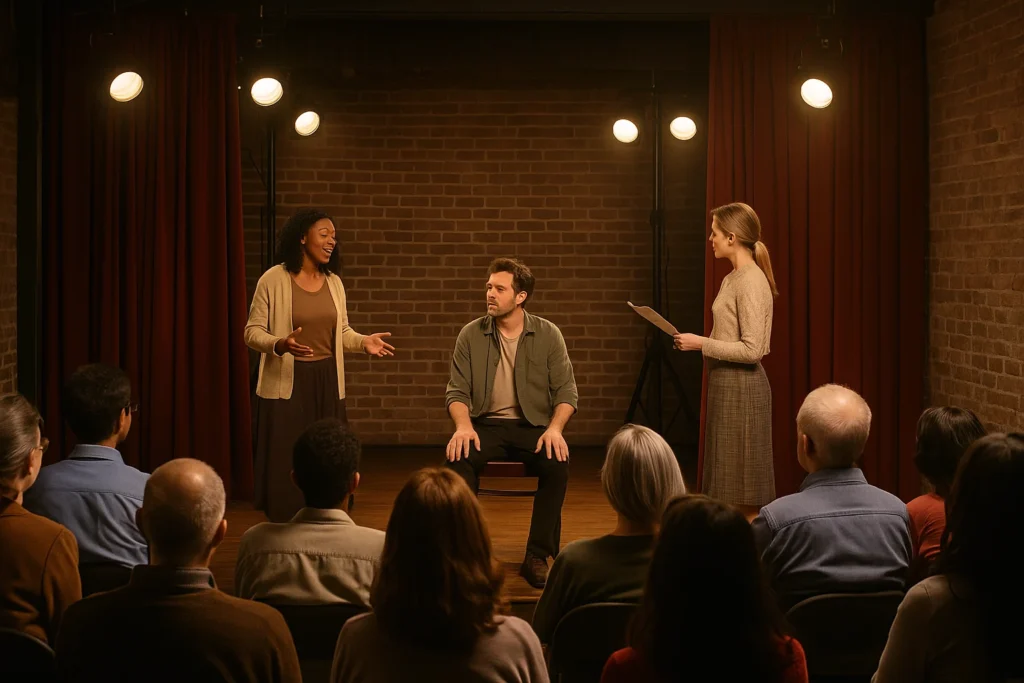Introduction: A Resurgent Overture – The Unexpected Revival of Local Theater
In an era seemingly consumed by the glowing screens of streaming platforms and the colossal budgets of blockbuster franchises, a quiet yet profound revolution is taking place, largely unnoticed by the mainstream but deeply felt within local communities. Across towns and cities, from the humble stages of local church halls to the reimagined grandeur of repurposed industrial spaces, community theaters are experiencing an extraordinary renaissance. These intimate venues, far from the dazzling lights of Broadway or the West End, are not merely surviving; they are thriving, breathing vibrant new life into local arts scenes, igniting creative sparks, and meticulously weaving the frayed threads of social connection back into robust tapestries. This comeback is not just a passing trend; it’s a testament to the enduring human need for shared experiences and authentic narratives.
Consider the compelling statistics that underscore this dramatic shift: attendance at community theaters in both the U.S. and U.K. has soared by an impressive 40% since 2023, a testament highlighted in recent cultural reports compiled by organizations like the National Endowment for the Arts and the UK’s Arts Council. This surge isn’t simply a fleeting wave of nostalgia for a bygone era or a quaint novelty. Instead, it speaks to a deeper, more fundamental human yearning – a profound desire for authentic, shared experiences in a world that, despite its digital interconnectedness, often leaves individuals feeling isolated and detached. It’s a primal return to the very roots of storytelling, where the energy is palpable, the emotions are raw, and the human element reigns supreme, offering an antidote to the curated perfection of digital entertainment. People are seeking genuine interaction, the thrill of the unpredictable, and the unique bond that forms when stories unfold live before their very eyes.
The Grand Act: Unpacking the Reasons Behind Community Theater’s Flourishing Revival
1. The Post-Pandemic Echo: A Collective Hunger for Live Connection
The recent past, marked by the hushed solitude of lockdowns and the omnipresence of virtual interactions, has left an indelible imprint on our collective psyche. We emerged from a period where human contact was restricted, and digital substitutes became the norm. Now, there’s a palpable yearning, a deep-seated craving for face-to-face engagement, for the shared breath within a communal space, for the physical presence of others. Community theaters perfectly encapsulate this profound longing, offering an experience that no digital stream, however high-definition, or virtual reality simulation, however immersive, can ever truly replicate. It’s the unfiltered thrill of live performance, the spontaneous ebb and flow of energy between performers and audience members who are all breathing the same air, sharing laughter or tears, and the beautiful unpredictability inherent in human storytelling that makes each performance a unique, unrepeatable event.
As Maria Gonzalez, a seasoned theater director based in the vibrant artistic landscape of Chicago, eloquently puts it, her voice resonating with years of experience under stage lights, “There’s an undeniable magic that unfurls when you witness actors sharing the very same air as you, their emotions raw and exposed. No complex algorithm, no matter how sophisticated, can ever replicate that raw, immediate human connection. It’s about being present, truly present, in a moment that is unfolding just for you and everyone else in that room.” This sentiment resonates deeply with audiences who have grown weary of curated, pre-packaged entertainment, seeking instead the immediate, unscripted beauty of live art, a true escape from the digital echo chamber.
2. A Symphony of Voices: The Emergence of Diverse, Locally-Rooted Narratives
Unlike the often risk-averse, commercially-driven scripts favored by large-scale productions that aim for universal appeal and often dilute unique perspectives, community theaters are courageously embracing the spirit of experimentation and specificity. They are becoming fertile ground for a new wave of diverse and localized storytelling. Local playwrights, with their fingers firmly on the pulse of their communities, drawing inspiration from the streets, the coffee shops, and the shared histories around them, are fearlessly crafting and debuting socially relevant and culturally rich narratives. These are not just plays; they are vibrant mirrors reflecting contemporary society – tackling complex, often challenging issues such as the intricacies of immigration experiences, the pressing urgency of climate change and its local impacts, and the often-stigmatized topic of mental health, all presented in ways that resonate profoundly and intimately with their audiences because they reflect their own lives and concerns.
Consider the remarkable work of Voices Unbound, a Toronto-based theater collective that has garnered significant acclaim. This group dedicates itself to staging performances written entirely by refugee artists, individuals who carry incredibly powerful and often untold stories. Through their plays, they transform deeply personal struggles and triumphs into powerful, universally resonant narratives that transcend cultural boundaries and foster profound empathy and understanding among diverse audience members. Such initiatives highlight the unique capacity of community theater to give voice to the marginalized and provide a platform for stories that might otherwise remain unheard or overlooked by mainstream media.
3. Bridging Generations: Intergenerational Troupes as Unifying Forces
One of the most heartwarming and intrinsically valuable aspects of the community theater revival is its inherent inclusivity and its ability to act as a social glue. These stages are not exclusive enclaves for seasoned professionals or aspiring young talents; they are welcoming havens for everyone who harbors even a nascent passion for performance, a desire to connect, or simply a willingness to learn. It’s a beautiful, dynamic melting pot where retired teachers, drawing on a lifetime of experience, find common ground with enthusiastic high school students brimming with youthful energy, and newly arrived immigrants collaborate with long-time residents, all converging, sharing skills and laughter, to create something truly extraordinary.
Imagine the heartwarming scene in Melbourne, where a 70-year-old retired engineer, perhaps initially hesitant but now fully committed, shares the stage with a 16-year-old aspiring actor in a play that cleverly explores the nuances of generational divides. This unlikely pairing fosters mutual respect, profound learning, and often deep friendships, enriching not only the performance itself but also the lives of all participants, both on and off stage. Similarly, in Cape Town, the Ubuntu Arts theater group masterfully blends traditional African storytelling with contemporary dramatic forms, creating performances that are both educational and deeply moving. This fusion draws incredibly diverse audiences of all ages who come together to witness this vibrant fusion of old and new, celebrating shared heritage while embracing modern expressions. These intergenerational collaborations are not just about producing engaging theater; they are about building bridges, fostering understanding, and strengthening the very fabric of society across demographic divides.
4. Civic Endorsement: Cities Investing in Grassroots Arts Initiatives
Recognizing the multifaceted benefits that local theaters bring – extending far beyond mere entertainment to encompass vital social cohesion, economic revitalization, and the nurturing of local talent – cities worldwide are increasingly stepping up their support. This isn’t just an act of cultural patronage or charity; it’s a strategic, forward-thinking investment in the cultural fabric, economic health, and overall well-being of their communities, understanding that vibrant arts contribute directly to quality of life and civic pride.
- Melbourne’s innovative Micro-Grant Program stands as a shining example of this enlightened approach, providing crucial financial lifelines of up to $10,000 to small theaters. This relatively modest sum can make an enormous difference, enabling them to cover production costs, acquire necessary props, or even pay modest stipends to their dedicated volunteers, thus allowing them to bring their creative visions to life without the constant specter of debilitating financial strain.
- In Toronto, the ingenious “Neighborhood Stages” Initiative transforms previously vacant storefronts, often eyesores in commercial districts, into vibrant, temporary pop-up performance spaces. This not only breathes life into dormant urban corners but also makes art accessible to everyday passersby, inviting spontaneous engagement and discovery. It’s a clever way to utilize existing urban infrastructure to foster cultural activity.
- And in Cape Town, the proactive Arts Revival Fund directly addresses the perennial financial challenges often faced by amateur theaters, helping them cover essential operational costs like rent for rehearsal spaces, equipment upgrades, and even utility bills, thus securing their longevity and broader impact within the community. These municipal initiatives underscore a growing understanding among urban planners and policymakers of the indispensable role community arts play in fostering urban vitality, attracting residents and businesses, and creating a unique sense of place.
5. Digital Echoes: Social Media’s Role in Amplifying Local Productions
In today’s hyper-connected world, where information travels at the speed of light, the power of digital virality extends far beyond pop culture phenomena, reaching even the most unassuming local productions. A single, captivating TikTok video showcasing a poignant scene, or an aesthetically pleasing Instagram reel offering a glimpse behind the scenes, can instantaneously catapult a tiny local play into a widespread sensation, proving that authentic storytelling, regardless of its initial budget or humble origins, can capture global attention and resonate across diverse audiences.
Consider the remarkable case of a high school’s impressively low-budget adaptation of Shakespeare’s Macbeth in a quiet Ohio town. A short clip of its dramatic, innovative finale, perhaps featuring a clever lighting trick or a particularly powerful performance, unexpectedly went viral, garnering an astonishing 2 million views across various platforms. This digital phenomenon led directly to packed houses and unexpected renown for the young performers and their dedicated teachers, bringing their small-town production to a national audience. Similarly, a community theater in London, known for its unique punk-rock Shakespeare interpretation that defied traditional expectations, experienced sold-out shows for weeks after an influential social media personality, perhaps a popular vlogger or arts critic, shared their performance with an enthusiastic endorsement, demonstrating the undeniable power of digital word-of-mouth in filling seats and generating widespread buzz that transcends geographical boundaries.
The Ripple Effect: Beyond Entertainment – The Profound Impact of Community Theaters
6. Catalysts for Renewal: Revitalizing Neglected Neighborhoods
Community theaters often serve as powerful anchors for urban renewal, acting as catalysts for positive change in areas that have seen better days. Old, abandoned buildings, once symbols of decay, neglect, and economic stagnation, are being reimagined and repurposed with astonishing creativity, transforming into vibrant creative hubs that breathe new life into forgotten corners of cities. This transformation is not just aesthetic; it spurs economic activity, attracting new businesses and residents.
In the heart of Detroit, a sprawling, disused auto factory, once a monument to a fading industrial era, has been magnificently reborn as The Motor City Playhouse. This dynamic venue now hosts plays that not only entertain but also celebrate the city’s rich industrial heritage and its indomitable, resilient spirit, becoming a focal point for community pride and a symbol of urban resurgence. Likewise, in Lisbon, a crumbling, melancholic cinema, long shuttered and forgotten, found a dramatic new lease on life as Teatro da Vila, drawing both curious tourists and appreciative locals, injecting fresh energy and cultural vibrancy into its surrounding district, often leading to the opening of new cafes and shops nearby. These transformations vividly illustrate how art, specifically community theater, can be a powerful engine for urban regeneration and a beacon of hope.
7. Nurturing the Stars of Tomorrow: A Launchpad for Future Talent
It’s a well-known secret within the entertainment industry, a truth often whispered with reverence: many of the world’s most celebrated A-list actors – luminaries such as the incomparable Meryl Streep, the commanding Denzel Washington, and the powerful Viola Davis – honed their craft and discovered their profound passion for acting on the humble, often makeshift stages of community theaters. These local stages are not just places for recreation or amateur pursuits; they are invaluable training grounds, meticulously nurturing raw talent, providing crucial hands-on experience, and allowing aspiring performers to experiment, fail, and ultimately grow in a supportive environment. They are the crucibles where confidence is built and essential performance skills are developed, potentially launching the next generation of stars onto the global stage, proving that greatness often begins in unexpected, unassuming places.
8. Weaving the Fabric of Society: Strengthening Social Bonds
In a world that often feels increasingly fragmented, individualized, and digitally mediated, where real-world interactions can seem to diminish, theater, particularly at the community level, acts as a potent force for cohesion and connection. It brings people together, both as participants and as audience members, fostering a profound sense of shared experience and collective identity that is increasingly rare.
A compelling study conducted by the esteemed University of London revealed a significant correlation: individuals who regularly attend local theater performances reported notably higher levels of community connection and belonging. This finding underscores the profound social utility of these venues, demonstrating their power to foster genuine human interaction and combat loneliness. Moreover, in Japan, a poignant movement known as Machiza (literally “Town Theater”) leverages the transformative power of performance to mend and strengthen relationships in rural areas grappling with the multifaceted challenges of population decline and social isolation, demonstrating theater’s remarkable capacity to heal, unite, and revitalize communities at their very core.
The Next Scene: Navigating Challenges and Charting the Course Ahead
9. The Persistent Struggle: Funding Remains a Tightrope Walk
Despite the growing recognition of their value and some encouraging increases in grant funding from local and national bodies, many community theaters continue to operate on razor-thin, shoestring budgets. The passion, dedication, and creative energy of those involved are boundless, but financial resources often remain frustratingly scarce. This means every dollar counts, and every decision is critical. In this challenging landscape, innovative funding models such as creative crowdfunding campaigns that tap into community goodwill and strategic corporate sponsorships are becoming not just beneficial, but absolutely essential for their survival, continued operation, and future growth, requiring constant creativity, entrepreneurial spirit, and tireless outreach efforts.
10. The Battle for Attention: Innovating in a Noisy World
In an era saturated with an overwhelming amount of digital content and constant demands on attention from myriad sources, community theaters face an ongoing battle for visibility and relevance. To cut through the digital noise and attract new audiences, they must innovate relentlessly. This includes exploring exciting new formats such as interactive plays that involve the audience directly in the narrative, immersive experiences that transport spectators into the heart of the story, blurring the lines between performer and observer, and hybrid shows that cleverly blend live performance with digital elements, expanding their reach and appeal to a broader, tech-savvy audience who might not typically consider live theater. This adaptability is key to their future.
The Standing Ovation: The Future of Theater is Decidedly Local
The undeniable resurgence of community theaters serves as a powerful testament to a fundamental, timeless truth: one does not require a Hollywood-sized budget, a glittering Broadway marquee, or a star-studded cast to tell a truly captivating and meaningful story. These unassuming stages are profound reminders that the essence of art transcends mere spectacle and commercial appeal. It is rooted in the profound beauty of human connection, the shared experience of raw and authentic emotions, and the enduring, transformative power of live storytelling that has captivated humanity for millennia.
As more and more individuals, weary of digital isolation and seeking genuine human interaction, rediscover the unparalleled magic that unfolds on these intimate stages, one clear message resonates with increasing volume: the curtain is not falling; it is, in fact, just beginning to rise on this exhilarating, grassroots revival. The future of theater, vibrant, resilient, and deeply human, is unmistakably local, promising a rich tapestry of stories yet to be told, dreams yet to be realized, and invaluable community connections yet to be forged. It’s an invitation to experience art not just as an observer, but as a participant in something truly special.
Curious to experience the magic firsthand? Don’t hesitate to check local listings in your area—you might be wonderfully surprised by the compelling performances playing just around the corner, waiting to ignite your imagination and connect you with your community. 🎭



